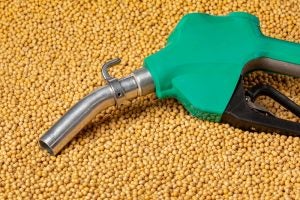Whether buying Christmas presents, purchasing a new car, or shopping for food, everyone is feeling the pinch of inflation. Grocery prices have increased by 21 percent (from January 2020 to August 2022), and retail fat and oil prices have increased by 30 percent — with soybean oil a key ingredient in frying and baking, including its use in margarine, cooking oils, and salad dressings. Pair its food service popularity with how soy oil is used for biofuel production, which has quadrupled over the past decade, and it’s no wonder soy oil is a hot topic right now.
But a new study only adds to evidence that U.S.-grown soybeans are well suited for people looking to cook, fuel up, or find other sustainable solutions.
The United Soybean Board partnered with Purdue University on a Food and Fuel study to evaluate whether the increased use of soybean oil in biofuels has contributed to the rising retail prices of food products for consumers.
“The share of soybean oil going toward biofuel production has quadrupled over the past decade. In the most recent marketing year, 43 percent of all soybean oil used in the United States went toward biofuel production. Beginning in the fall of 2020, crude wholesale soybean oil prices began to rise and have approximately doubled since that time at the same time that retail food prices have been rising,” wrote food and agriculture economist at Perdue University Jayson Lusk.
One key element missing from this equation is that only one-fifth of the soybean is oil: the vast majority of the soybean is a meal used as a high-quality protein in animal diets. This expanded crush for oil to meet biofuel demand creates increased availability for the meal, driving down the price of animal protein products. This partially offsets the growth of oil and bakery prices, leaving the overall “food at home” portion of the Consumer Price Index essentially unchanged. This can be attributed to meat prices representing a larger share of the CPI than fats and oils.
“The economic model we created links the farm supply of soybeans to retail demand for various food products. What we found, after assessing the impact of rising soybean oil demand on prices at the grocery store, was little change to the CPI,” Lusk said. “While the increased demand for biofuels pushed up retail prices for oil between 0.16 percent percent and 4.41 percent across different categories, retail animal product prices for dairy, beef, pork, chicken, and eggs declined between -0.01 percent and -0.16 percent.”

A 20 percent increase in the quantity of soybean oil demanded for use in biofuels generates the following price impact breakdown (all else equal):
- Soybean oil increase of 0.16 percent in retail price for frying and baking, 0.82 percent in retail margarine price, 4.41 percent in salad/cooking oil and 0.16 percent in other oil-containing food items.
- Animal protein decrease of 0.16 percent in retail egg prices, 0.13 percent in retail chicken prices, 0.06 percent in retail pork prices, 0.02 percent in retail dairy prices and 0.01 percent in retail beef prices.
- Additionally, farm-level soybean prices increased 0.73 percent, farm revenue for soybean producers increased 0.92 percent and overall crude soybean oil prices increased 8.17 percent.
“Research continues to support our industry philosophy that U.S. Soy has the unique ability to solve two existential challenges: food security and renewable energy. Further, this study shows the increase in biofuels has had limited impact on inflation at the grocery store,” said Mac Marshall, USB vice president of market intelligence. “It’s also important to keep in mind many factors contribute to rising food prices, such as energy and transportation costs, higher wage rates and supply chain disruptions, not to mention drought in the Western U.S. and the Russia-Ukraine war.”
The United States Department of Agriculture’s Economic Research Service estimates that for every $1 consumers spend on food, only about $0.14 is a result of the cost of raw farm commodities, implying $0.86 is a result of other post-farm factors such as transportation, processing, packaging and retail costs.
Click here to access the full study — Food and Fuel: Modeling Food System Wide Impacts of Increase in Demand for Soybean Oil — or visit Jayson Lusk’s blog for a recap of the findings.


